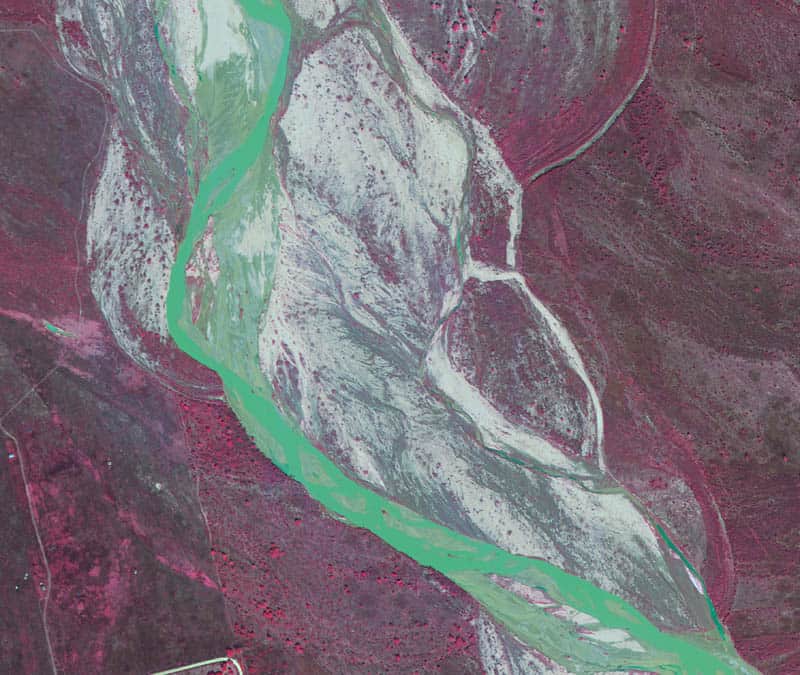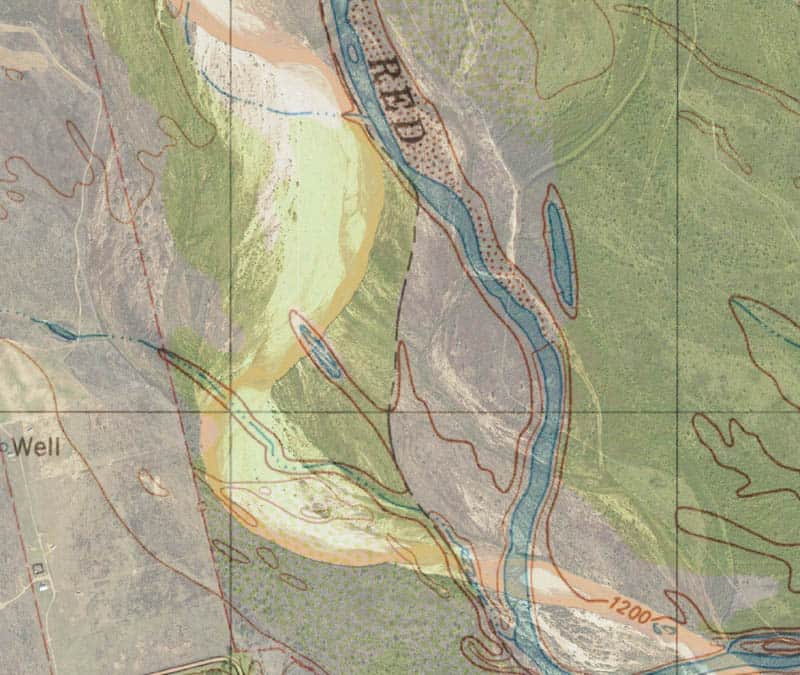BTW, here's a link to the report by the boundary commissioners for Texas and Oklahoma, Stiles and Kidder, respectively, that mentions with respect to the reach of the Red River along the North side of Clay County, Texas was one in which no avulsions had been reported. See page 33 of the report linked below (page 36 of the pdf):
http://www.glo.texas.gov/ncu/SCANDOCS/archives_webfiles/arcmaps/webfiles/arcmaps/pdfs/3//3061.pdf
Considering that the federal court held in 1981 that in fact an avulsive change of the Red River had taken place in 1908, in Clay County, probably the single most important investigative task with respect to the Red River boundary isn't locating the gradient boundary, but revisiting the possible existence of other avulsions that were not identified by Stiles and Kidder.
Kent McMillan, post: 423180, member: 3 wrote: Yes, I saw that. I trust you noticed that the "Welcome to Oklahoma" for travellers headed in the opposite direction was in the form of an advertisement for a church.
Yes, I saw the church sign. There is an official sign way to the north past the north end of the bridge.
Kent McMillan, post: 423180, member: 3 wrote: Yes, I saw that. I trust you noticed that the "Welcome to Oklahoma" for travellers headed in the opposite direction was in the form of an advertisement for a church.
In contrast; as one is entering Texas southbound on Interstate 35 and crossing the gradient boundary line on the grade up the hill; the first thing one sees is this:
It's another mile before you get to the state funded "visitor's center".
ps - What in the world is a "fleshlight" ?
paden cash, post: 423203, member: 20 wrote: ps - What in the world is a "fleshlight" ?
My guess is that it's a novelty item, the flesh-heavy being more commonly available in Okieland.
Frank Willis, post: 423068, member: 472 wrote: That part of the Red River looks to me like it is just a big sand bed that gets varying threads of water in it, with no permanent channel anywhere. A wiggly thing like that will never stay still long enough to keep anyone happy.
Frank,
I voiced a similar sentiment in an earlier post. As a geologist, it appears to me to be a hybrid between a braided stream and a meandering stream. It may grade from mostly being a braided stream in the west to more of a meandering stream to the east as the sand bedload decreases. Others have postulated that it is definitely a meandering stream.
In the Chapter VIII Notes of the 2009 Manual (page 232; see attachment below) the Red River is classified as a braided stream. The preface of the notes state, "The case studies on pages 225 to 262 and 268 to 272 are used by permission from River & Lake Boundaries by James A. Simpson. Section 8-94 (page 201) of the 2009 Manual lists eleven, "summary statements about avulsions relative to Federal interest land that are important for surveyors to understand". Item (7) is:
In a braided stream that is bare of permanent upland vegetation between braid channels, changes of channel that occur in the bed of the river between the outer braids are not avulsions (see Peterson v Morton, 465 F. Supp. 986 (D. Nev. 1979), remanded by, vacated by, in part on other grounds, Peterson v. Watt, 666 F. 2d 361 (9th Cir. Nev. 1982) described below).
Kent McMillan, post: 423075, member: 3 wrote: In this case, the experts were actual scientists who were asked to investigate the physical evidence that indicated whether or not a channel had existed in 1821, the operative date of the treaty that fixed the boundary between Texas and what was to become Okieland. Their reports were published by the Bureau of Economic Geology of the University of Texas and extended well beyond the obvious lack of mobile home foundations that would indicate that the land had anciently been part of Okieland.
I presume that the reference you cite mention above is University of Texas Bulletin 2327, Investigations on the Red River Made in Connection with the Oklahoma-Texas Boundary Suit, by E. H. Sellards, B. C. Tharp, and R. T. Hill. 174 p., 2 figs., 6 maps, 9 plates, 1923. The link is to a web page with an option to download a 71 MB PDF file. The PDF file includes the color plates.
The introductory section lists the many scientists "engaged in the investigations" for the U.S., Oklahoma and Texas and the various maps prepared for the boundary suit (see pages 11-16). I particularly enjoyed reading the "Summary of physiographic investigations made in connection with the Oklahoma-Texas boundary suit", by R.T. Hill (pages 157-172), esp. the section describing the Red River as a "sand river". To give credit, Dr. Hill does state that the Red River is NOT a braided stream.
After the index are several photos and the color plates of topography and geology prepared by the Texas scientists. Kent is correct that none of the photos show any ancient mobile home foundations.
Dave Karoly, post: 423162, member: 94 wrote: That is an interesting decision. The Court found the highway prevented the river from returning to its original channel near the so-called Wheat Field Bank. The Court doesn't do a very adequate job of describing exactly where the Wheat Field Bank is located.
Dave,
Here is a link to a BLM plat approved in 2015 that shows the medial line of the Red River as monumented by Richard J. Widmar in 1987, in accordance with the 1986 U.S. District Court decision Currington v. Henderson and the adjusted record meanders of the right bank gradient of the Red River in accordance with the 1981 U.S. District Court Decision James V. Langford.
If you want to know what is in the special instructions, you'd likely have to file a FOIA request with the New Mexico BLM office and request any information in Group File No. 225, Oklahoma regarding the survey.
For convenience, here is another link to the James V. Langford decision.
I could only find Currington v Henderson on Scribd so you may not be able to download it (pardon also the fact that it is hosted by a political organization).
Gene Kooper, post: 423262, member: 9850 wrote: I presume that the reference you
citemention above is University of Texas Bulletin 2327, Investigations on the Red River Made in Connection with the Oklahoma-Texas Boundary Suit, by E. H. Sellards, B. C. Tharp, and R. T. Hill. 174 p., 2 figs., 6 maps, 9 plates, 1923. The link is to a web page with an option to download a 71 MB PDF file. The PDF file includes the color plates
Yes, that 174-page report of scientific investigations by the Texas scientists E.H. Sellards, R.T. Hill, B.C. Tharp, E.P. Schoch, and P.T. Seashore summarizes the work that was done to support the Texas position in the litigation.
E.H. Sellards' bio:
https://tshaonline.org/handbook/online/articles/fse17
Robert T. Hill's bio:
https://en.wikipedia.org/wiki/Robert_T._Hill
B.C. Tharp's ecological investigations were made while he was a graduate student at the beginning of a distinguished career:
https://w3.biosci.utexas.edu/prc/pdfs/Graham-Lundellia13.pdf
Gene Kooper, post: 423261, member: 9850 wrote: As a geologist, it appears to me to be a hybrid between a braided stream and a meandering stream. It may grade from mostly being a braided stream in the west to more of a meandering stream to the east as the sand bedload decreases. Others have postulated that it is definitely a meandering stream.
In the case of the boundary between Texas and Oklahoma, it would be foolish to overlook the fact that the US Supreme Court has already made certain determinations nearly 100 years ago. In other words, certain questions related to the South bank of the Red River are not novel ones. The main fact of the Red River is that its channel has meandered historically and will continue to.
Gene Kooper, post: 423263, member: 9850 wrote: Dave,
Here is a link to a BLM plat approved in 2015 that shows the medial line of the Red River as monumented by Richard J. Widmar in 1987, in accordance with the 1986 U.S. District Court decision Currington v. Henderson and the adjusted record meanders of the right bank gradient of the Red River in accordance with the 1981 U.S. District Court Decision James V. Langford.
If you want to know what is in the special instructions, you'd likely have to file a FOIA request with the New Mexico BLM office and request any information in Group File No. 225, Oklahoma regarding the survey.
For convenience, here is another link to the James V. Langford decision.
I could only find Currington v Henderson on Scribd so you may not be able to download it (pardon also the fact that it is hosted by a political organization).
Unfortunately there are no field notes available on-line.
WHEW! I'm glad to see there are competent surveyors who have the passion to keep up with all of that mess (so I don't have to). I'm with Paden: Avoid Red River surveys altogether!
jakethebuilder, post: 423438, member: 9380 wrote: WHEW! I'm glad to see there are competent surveyors who have the passion to keep up with all of that mess (so I don't have to). I'm with Paden: Avoid Red River surveys altogether!
After some experience in my career I'll even go one further and say I don't care much for any riparian boundary work. While riparian lands that are a part of the PLSS have plenty of research material available there is one fly that always seems to get in the ointment, the surveyor for the other guy on the other side of the fence.
Bounding gov't. riparian lots usually have two constant components; the fixed land lines that adjoin the lots and the river itself. Most all surveyors that find themselves in an adversarial, or at least an opposing situation with another surveyor, find their data and the others' data agree on those points. It is the application of the available rules and instructions concerning river movement that get in the way. There is simply no one single answer.
Charging a client a buttload of money to come up with an answer and then having to tell said client that the neighbor's surveyor (that came up with a different answer) could be right also is a no win position. A riparian boundary dispute has only one final termination: death of one or both of the litigants. Anything else will remain in appeals until hell freezes over. And the whole time it's tied up in adjudication...ol' man river keeps wandering and changing like he has forever.
While surveys and court cases make interesting fodder for students and textbooks, they are an exercise in futility. I will reiterate: If a surveyor is approach to determine a riparian surface boundary; walk away. If approached to determine a boundary concerning sub-surface rights; run.
So can the Red River be considered a braided river and there exists a wide river bed and not a bed constrained by a low water channel?
J Tanner, post: 423452, member: 7358 wrote: So can the Red River be considered a braided river and there exists a wide river bed and not a bed constrained by a low water channel?
I'd say that the Red River is mainly a meandering river which has braided flow within its channel at lower stages than flowing full from bank to bank, but that functionally the small-scale braided flow is of consequence compared to the larger-scale meandering and the associated processes of accretion and erosion by which the banks of the river shift.
Generally, the bed of the Red River is bounded by cut banks. However, there are areas where the South bank of the river is an accretion bank with a very flat slope and without any obvious cut bank. That is where the gradient boundary method applies to realize this language of the decision of the US Supreme Court in Oklahoma v. Texas:
6. The boundary between the two states is on and along that bank at the mean level attained by the waters of the river when they reach and wash the bank without overflowing it.
7. At exceptional places where there is no well defined cut bank, but only a gradual incline from the sand bed of the river to the upland, the boundary is a line over such incline conforming to the mean level of the waters when at other places in that vicinity they reach and wash the cut bank without overflowing it.
BTW, here's that link to some stream gauging data for the Red River that show the variations in stage, i.e. commonly occuring stages and infrequent flood stages.
Kent McMillan, post: 423461, member: 3 wrote: I'd say that the Red River is mainly a meandering river which has braided flow within its channel at lower stages than flowing full from bank to bank, but that functionally the small-scale braided flow is of consequence compared to the larger-scale meandering and the associated processes of accretion and erosion by which the banks of the river shift.
Uh, make that " ...but that functionally the small-scale braided flow is of no consequence compared to the larger-scale meandering ..."
Kent McMillan, post: 423467, member: 3 wrote: Uh, make that " ...but that functionally the small-scale braided flow is of no consequence compared to the larger-scale meandering ..."
No problem amigo. We're ALL getting used to quick 180 degree reversals of publicly stated opinions. 😉
paden cash, post: 423470, member: 20 wrote: No problem amigo. We're ALL getting used to quick 180 degree reversals of publicly stated opinions.
This was not a reversal. A reversal would describe the situation in which if I was driving to Wichita Falls and found myself in Lawton. I would naturally take the next exit and reverse course until Lawton was less than a speck in the rear view mirror.
My post was more in the nature of a correction. Corrections seem to be in short supply at the moment, which Is why I'm willing to share.
Kent McMillan, post: 423695, member: 3 wrote: This was not a reversal. A reversal would describe the situation in which if I was driving to Wichita Falls and found myself in Lawton. I would naturally take the next exit and reverse course until Lawton was less than a speck in the rear view mirror.
My post was more in the nature of a correction. Corrections seem to be in short supply at the moment, which Is why I'm willing to share.
I think I understand what you're saying...it's just an 'alternative' reversal..;)







